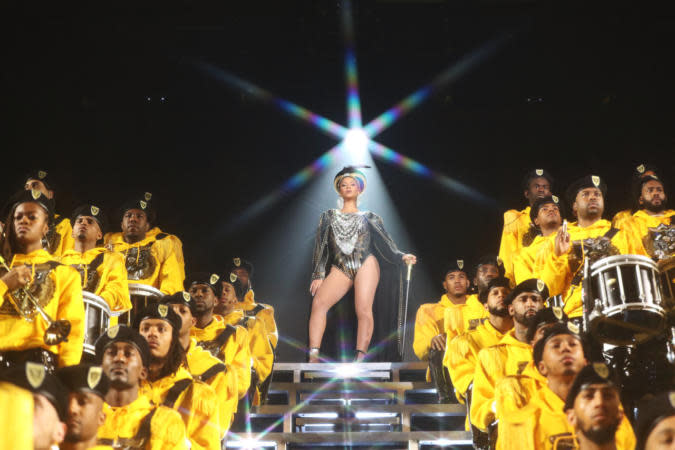What is the Black National Anthem? A Song of and for the People

- Oops!Something went wrong.Please try again later.
- Oops!Something went wrong.Please try again later.
A lot of people are familiar with the national anthem, the song that’s usually sung at the start of all kinds of sporting games, along with government ceremonies and events across the country. But, in the U.S., there is also the Black National Anthem. It is significantly younger than America’s national anthem, but it holds serious significance for the Black community and continues to be sung today.
From Mahalia Jackson to Beyonce, the Black National Anthem is a rallying cry that continues to move hearts and inspire countless people. Find out how it came to be and why it’s still so inspirational today.
What is the Black National Anthem?
Beyonce may have introduced an entirely new demographic to the Black National Anthem, but it’s by no means new. Similar to a national anthem that represents a country, the Black National Anthem was created to instill pride within the Black community and inspire people to keep pushing forward. The actual song is Lift Every Voice and Sing, which was created by James Wheldon Johnson in 1900. While James created the lyrics, his brother John Rosamond Johnson composed the music.
The first time it was sung was in 1900 at Stanton School, a segregated school in Jacksonville, Fla. where James Weldon Johnson was the principal. He originally set out to write a poem to celebrate late President Abraham Lincoln’s birthday. However, Johnson ultimately wrote an uplifting piece that acknowledged the oppression Black people had faced for centuries before and currently, while still maintaining optimism for what the future held.
Why is the Black National Anthem Important?
To understand why Lift Every Voice and Sing has persisted for over 120 years, a quick historical review is necessary. When the song was first created, the Reconstruction era had just ended, and in many ways much of the progress achieved by Black Americans between the 1870s and 1880s was quickly being eroded because of legislation like Plessy v Ferguson which ushered in segregation with its “separate but equal” pretense. Likewise, Jim Crow was building momentum along with a resurgence of KKK activities.
To counterbalance this hostile environment, many Black communities focused on self-sufficiency. From schools, banks, and even social organizations and newspapers founded by Black leaders, the emphasis was on fostering growth and development in the Black community at all costs. Although the song began in Jacksonville, its popularity spread and served as a symbol of hope to encourage Black Americans everywhere to continue to persevere.
From a Song to an Anthem
As time progressed, the song was picked up by leaders in the community, including the NAACP, the National Association of Colored Women’s Clubs, and individuals like Booker T Washington. In 1919, the NAACP selected Lift Every Voice and Sing as the organization’s official song. This further elevated its popularity, ensuring that it would be sung at official functions, in churches, and as part of Emancipation Day and Negro History Week — which would later become Black History Month.
A Rallying Cry for Civil Rights
As time progressed, the Black National Anthem became a rallying cry for organizers pushing for better treatment and equality. It took on a political representation as protesters sang it in 1929 when Black train porters fought to unionize. Similarly, in 1936, the song was sung at the first conference of the National Negro Congress and would later become a common symbol of resistance and fighting for equality as the Civil Rights movement gained momentum in the 1950s.
The Black National Anthem is Temporarily Replaced
While Lift Every Voice and Sing was still an important song, for a while, it was replaced by the songs We Shall Overcome and even We Shall Not Be Moved during many of the marches, sit ins, and demonstrations that took place during the late 1950s and 1960s. However, by the 1970s the Black National Anthem was recentered as a symbol of resistance with many Black activists singing it. This was further underscored by the assassination of Dr. Martin Luther King Jr., which led to a new defiance against the status quo. At this point, Lift Every Voice and Sing began to be referred to as the anthem that honored the Black community as compared to the national anthem with its problematic lyrics and promises unfulfilled.
The Black National Anthem and Pop Culture
By the late 1970s, Lift Every Voice and Sing was restored as a cultural representation of not just Black endurance, but the demand for real change. Several major artists either sang renditions or included key lyrics in their own songs. This included James Brown, Ray Charles, Aretha Franklin, Stevie Wonder and Kim Weston.
As time progressed, the song also found its way into movies and shows with Spike Lee featuring a snippet in his classic movie Do the Right Thing and quotes referenced by Reverend Joseph Lowery during former President Barack Obama’s inauguration. Even popular Louisiana musician Jon Batiste has frequently featured the song on The Late Show with Stephen Colbert.
The Black National Anthem is Enduring
Whether at protests or Coachella, the Black National Anthem is an enduring hymnal that continues to represent the resilience of the Black community, as well as the unwavering commitment to exacting real change and equality. With more than a century of history behind it, Lift Every Voice and Sing will continue to be a song that inspires perseverance and strengthens a community.

